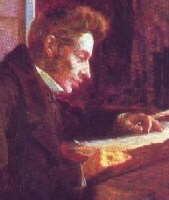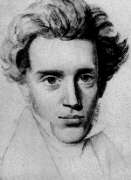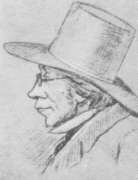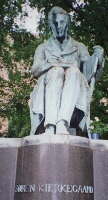Philosophy Pages
| Dictionary | Study Guide | Logic | F A Q s | ||
|---|---|---|---|---|---|---|
| History | Timeline | Philosophers | Locke | |||
Philosophy Pages
| Dictionary | Study Guide | Logic | F A Q s | ||
|---|---|---|---|---|---|---|
| History | Timeline | Philosophers | Locke | |||

|
Life and Works . . The Individual . . Freedom & Dread . . Subjective Truth Bibliography Internet Sources |
Born to a prosperous Danish family and educated at Copenhagen, Søren Kierkegaard deliberately fostered
his public reputation as a frivolous, witty conversationalist while suffering privately from severe melancholy and depression.
In a series of (mostly pseudonymous) books, Kierkegaard rebelled against the prevailing
Hegelianism of his time and developed many themes that would later be associated with the philosophy of existentialism.
Much of his work, including
Frygt og Bæven: Dialectisk Lyrik (Fear and Trembling) (1843),
Begrebet Angest
(The Concept of Dread) (1844),
(Purity of Heart is to Will One Thing) (1847), and Sygdomen Til Døden (The Sickness unto Death) (1849), expressed a profound interest in religious issues.

Kierkegaard also produced several more directly philosophical writings.
Om Begrebet Ironi (The Concept of Irony) (1841) was his dissertation at the University of Copenhagen.
Enten-Eller (Either-Or) (1843)
provides an extended contrast between aesthetic and ethical ways of life, with emphasis on the ways in which radical human freedom inevitably
leads to despair.
 The massive
Afsluttende Uvidenskabelig Efterskrift (Concluding Unscientific Postscript) (1846)
describes a third way of life, the possibility of living by faith in the modern world by emphasizing the
importance of the individual and developing a conception of
subjective truth.
The massive
Afsluttende Uvidenskabelig Efterskrift (Concluding Unscientific Postscript) (1846)
describes a third way of life, the possibility of living by faith in the modern world by emphasizing the
importance of the individual and developing a conception of
subjective truth.

Kierkegaard's influence on twentieth-century thought has been rich and varied. Most obviously, existentialist thinkers like Jaspers and Heidegger drew extensively on his analysis of despair and freedom. Although he directly addressed few of the social concerns that most interested his contemporary, Karl Marx, Kierkegaard has received ample attention from more recent Marxists, including Marcuse and Lukacs. Philosophers from Adorno to Wittgenstein have expressed great respect for the Danish master's thought.
|
Recommended Reading:
Primary sources:
Secondary sources:
Additional on-line information about Kierkegaard includes:
|
